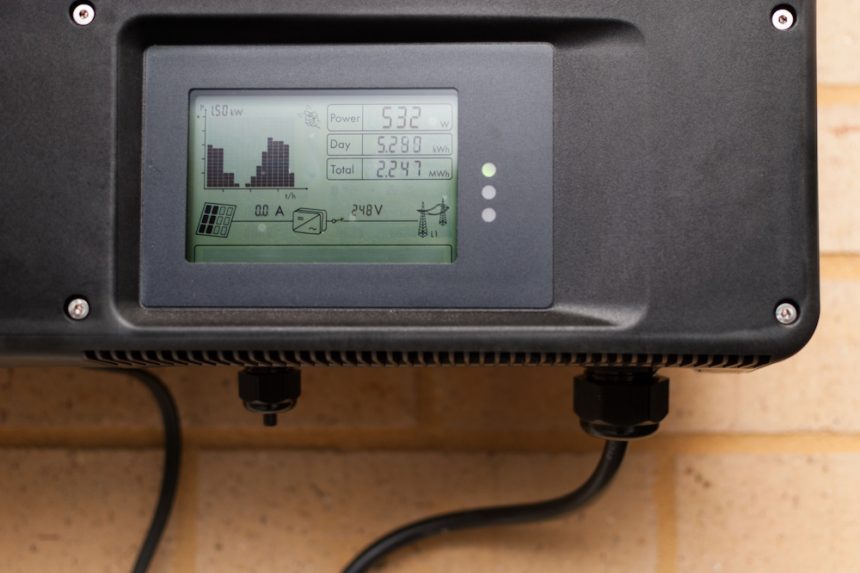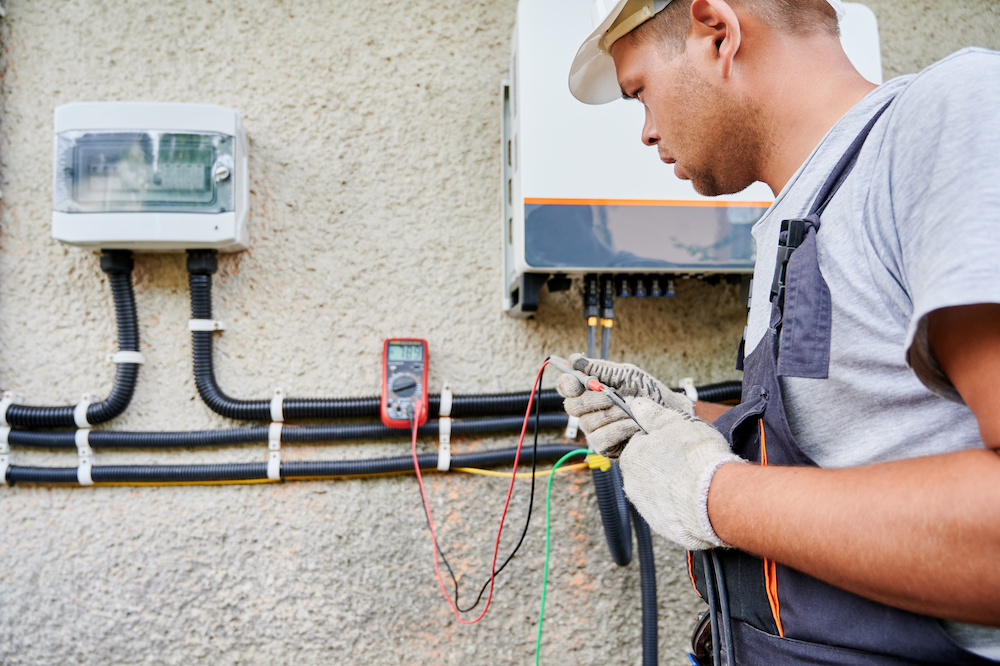The demand for solar inverters is growing. In fact, the market for the products is expected to reach $12 billion by 2024, according to a report from GTM Research.
It’s also estimated that there will be enough installed solar capacity to power the entire world’s electricity needs by 2030.
But what does a solar inverter do?
The most common use for solar panel inverters is to increase the voltage output of your solar panels so that you can use them in an electrical grid connection.
They can also help manage energy usage and energy production in your home.
Installing solar panels home can save money as they prevent your appliances from being damaged when too much electricity gets transmitted through them at once.
With the rapid growth in solar inverters, there are a lot of questions about what precisely solar inverters are and their types.
So, we’ll break down the ins and outs of these things so you can know what does a solar inverter do and make an informed decision about purchasing your next inverter.
What Is an Inverter?
An inverter or a traditional inverter is a power conversion machine that changes the direction of alternating current (AC) and converts it back to direct current (DC).
A traditional inverter is helpful for several reasons. You can use them in power plants and industrial applications, but they are also used in home appliances like washers, dryers, and refrigerators.
A traditional inverter’s job is to do this conversion while maintaining its operating parameters so that it can easily be used as a standalone device or plugged into your grid.
DC vs. AC Electric Current
If you’re unsure what the difference between alternating and direct current is, it may be time to brush up on your electricity basics.
The main difference between alternating current (AC) and direct current (DC) is that AC has a direct path from one source to another, while DC has a series of sources, which are connected in parallel.
AC power travels along a single path from one point to another. However, it can have multiple sources and pathways, confusing users.
A user may have several appliances plugged into a single outlet and not realize how much energy they use.
The realization comes at a certain time when they notice that the lights or computer are dimmer over time.
With a single-source device like this, all the power the appliance uses comes from that single point. There’s no method for the user to know where that energy comes from or which devices use the energy.
On the other hand, DC power simultaneously sends its energy across multiple paths. Each source sends electricity directly through its pathway before sending it to its destination.
It allows users to see exactly where their power is being sent without worrying about how much total energy is used at any given time.
What Does a Solar Inverter Do?
Aptly named, a solar inverter is a machine that transforms direct current (DC) from your solar panels into alternating current (AC) that your home or business can use.
The AC power is then used to power electronic equipment and appliances in your home or business.
Inverters are commonly used on large installations or systems where the energy production by the solar power inverters exceeds the load requirements of the appliances they power.
In general, inverters are only used in homes and businesses with multiple levels or separate structures within each group. An example of this is a garage or basement apartment complex.
The single inverter converts direct current from your solar cells into alternating current.
Electronic equipment within your home or business can then use this AC.
A typical inverter will have inputs for connecting to DC sources such as batteries and other solar system components such as charge controllers and voltage regulators.
The output side will connect directly to household AC circuits such as light switches, outlets, and receptacles.

Are There Different Types of Solar Inverters?
Yes, there are three types of solar inverters that you can choose from, namely:
1. String Inverter
The most popular ones are string inverters. A string inverter is a power supply converter that can convert DC voltage from a string of solar panels into AC voltage.
This technology is used in greenhouses and other areas where it’s essential to adjust how much power output each panel supplies.
These types of smart inverters can also be used as an emergency backup power source.
String inverters help you when you’re away from home or if you want to hook up multiple solar panels to charge your battery bank in one go.
String inverters are also typically mounted on the roof like a rooftop solar, unlike central inverters.
2. Power Optimizer
A power optimizer inverter is a type of inverter that boosts the voltage and frequency of solar cells in the panels. It helps them to work more efficiently.
This inverter has a higher power capacity than other inverters. It is used in places without sunlight available to run an entire system.
3. Microinverter
A microinverter is a device that converts DC power from a solar panel into AC power which you can use in your home.
The microinverters will take the DC power produced by the solar panel and convert it into usable AC power for your home.
The most common type of microinverter is called a “string inverter,” consisting of several small solar panels connected with wires or cables.
Microinverters can be connected to batteries or other electric appliances to charge them with clean energy generated by the sun.
How Long Have Solar Inverters Been Around?
The history of solar inverters is a long one. It started with the first solar panels, which made electricity from the sun.
This method improved previous methods of generating electricity, which often relied on fossil fuels like coal or natural gas.
But what if you wanted more power? What if you needed your car to run while you were at work? Or even want to charge up some electronics in your home?
The only way to get that power was using batteries or generators—not precisely ideal solutions. A new generation of solar inverters can help you generate more power than ever and solar panels can power a whole house.
When It All Started
Specifically, solar inverters have been around since the 70s, but they weren’t commercially available until the mid-90s.
In the 1960s, the first inverter was created for use in satellites. Until the 1980s, technology found no commercial applications.
Generac Holdings Inc. (GNRC) is believed to be the emerging and dominating company in the solar inverters market with the best growth outlook.
The Improvements
Many different solar inverters are available, each with specialized features and services. Some generate power from a single source, while others can simultaneously split power from multiple sources.
These devices are used in homes, businesses, and other buildings with rooftop solar panels.
Inverters were initially designed to be used with utility-scale systems on large rooftops like factories and warehouses.
The inverter converts the DC power generated by these panels into usable AC power for everyday use.
Today, solar inverters can be used with any solar panel system or battery bank.
They’re also commonly used in off-grid applications because they generate kilowatts of power from solar modules without being connected directly to an electrical grid.
Additionally, some modern inverters have built-in sensors that detect when there’s enough sunlight on the roof or ground.
They can automatically turn on whenever it’s dark enough, so, you don’t have to remember to flip a switch.
What’s the Best Way to Get Started?
When starting, it can be hard to know where to start with your solar system. You’ve got all these components, and there seems to be so much information that you don’t know which one is accurate for your needs.
Well, first of all, you should know that a solar inverter is the best way to go because they have all the features you need in one device.
They allow you to monitor your solar panels, charge your battery bank and appliances, and regulate power output.
They also protect your equipment from over-voltage and short-circuit conditions and reduce maintenance costs by increasing efficiency.
Inverters are also very useful for people living in areas where it’s not always sunny. It can help people who don’t want to install panels on their roofs (which can be expensive).
While solar inverters are not as versatile as other inverters, they have advantages. They can provide stable power, which means you don’t have to worry about heavy fluctuations in output when you’re not generating any power.
A Solar Inverter’s Purpose
Power issues can be frustrating when setting up a home automation system. So, if you’re interested in keeping your costs down while still benefiting from clean energy from the sun, a solar inverter might be just what you need.
In conclusion, the solar inverter is an excellent investment for homeowners. The price of the inverter is quite reasonable, and it can provide a great deal of energy savings to your home.
Purpose-wise, inverter-enabled solar panels can be used as backup power. So, you can use it when there is no sunlight.
You can also use it to charge batteries that run appliances like TVs, computers, lights, and other house appliances that require electricity.
So, the answer to “What does a solar inverter do?” is quite simple: it makes one’s life easier!

